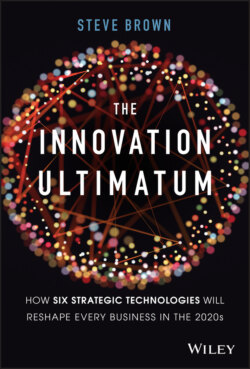Читать книгу The Innovation Ultimatum - Steve Brown - Страница 36
Seeing the World through a New Lens with Super Sensors
ОглавлениеSensors, turbocharged by AI to create “super sensors,” will lift the veil from the world, extend our existing five senses, and allow us to perceive the world more fully. Like the microscope before it, AI gives us a new lens to view the world through; a lens to experience the world in all its complexity and beauty. Super sensors will oversee business operations, monitor the operation of equipment, create new products, and provide us a more holistic view of people.
An exciting early example of super-sensing capabilities comes from the work of Dr. Dina Katabi, a professor and research lead at MIT's Computer Science and Artificial Intelligence Lab (CSAIL). Katabi's team has created a super sensor. What adds to the delight of this particular story is that it begins with Star Wars and ends with Star Trek.
As a child, Katabi was fascinated by the notion of “The Force” in the Star Wars movies. Her fascination persisted into adulthood. In Star Wars, Obi Wan Kenobi describes a mystical force that “surrounds us, penetrates us, and binds the galaxy together.” As she considered the fictional notion of The Force, Katabi realized that a real force surrounds us all—electromagnetic energy. If you flap your arms up and down, you literally create a disturbance in that force. Katabi wondered if sensing electromagnetic energy would let her see the world in a new way.
Katabi's research team built a simple wall-mounted sensor and fitted it inside a room. The sensor emits and receives radio frequency (RF) signals, much like a Wi-Fi hotspot. RF signals tend to pass through walls but bounce back from people. The sensor picks up reflected RF signals and feeds data into a neural network that makes sense of the reflected signal data.
To train the AI, Dr. Katabi's team captured video of people moving around inside the room. The AI was fed the video and RF sensor data as parallel inputs. The AI found complex associations between the RF sensor data and the video images and eventually correlated the two. With this insight, the AI can determine what is happening inside the room from just the RF sensor data and can register when a person is standing, sitting, or lying down. Since RF signals pass through most walls, the AI can “see” through them and also “see” in the dark. Amazing. Katabi plans to use the sensor to monitor elderly patients under care. The sensor instantly detects when patients suffer a fall and calls for help. Incredibly, the sensor also detects vital signs—a patient's breathing and heart rate—and their sleep state—awake, light sleep, deep sleep, and REM sleep. If you understand how well a person sleeps, you can tell a lot about their health. Disturbances in deep sleep can indicate depression or anxiety. Disturbances to REM sleep can indicate early-onset Alzheimer's. Alzheimer's is also indicated by repetitive patterns of movement or motion, which the sensor also detects. Changes in a person's gait can indicate the development of Parkinson's disease.
By applying AI to a low-cost, wall-mounted RF sensor, we can monitor vital signs, sleep states, falls, and provide clinical insight on the development of conditions that include Alzheimer's, COPD, Parkinson's, and depression. All without a single wire being attached to the patient. The system operates without using a camera, limiting privacy concerns. Patients are monitored with their full consent, comfortable in the knowledge that no video images are ever being gathered. The sensor enables clinicians to “see” a wealth of information, all gathered wirelessly. We started this story with Star Wars and ended up with the sick bay beds from Star Trek.
Super-sensing turbocharges simple sensors with AI to reveal more about our world. Google's “Project Soli” technology uses short-range radar signals and machine learning to detect fine-grain finger gestures. This approach will transform sliders, buttons, and twistable crowns on mobile and wearable devices into virtual controls. More super sensors are detailed in Chapter 10 on the future of healthcare. What other super sensors will we create? What super sensors will your business create?
